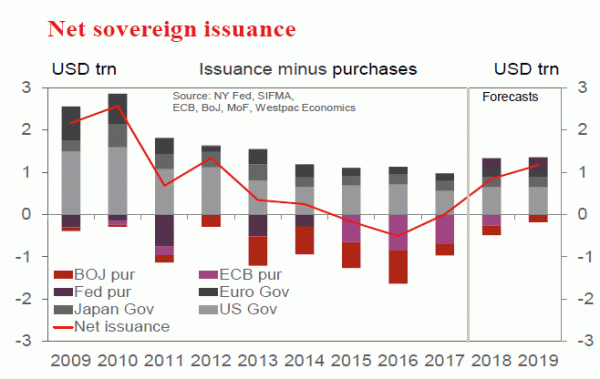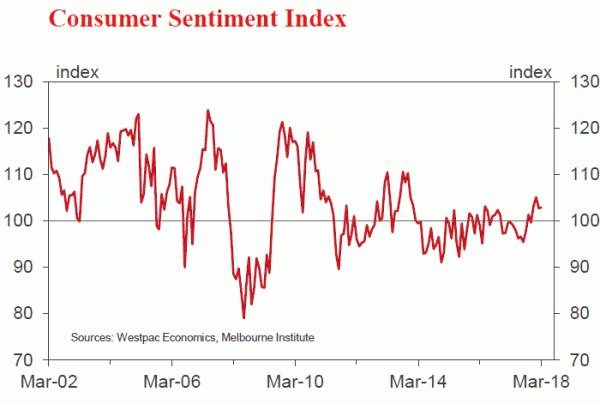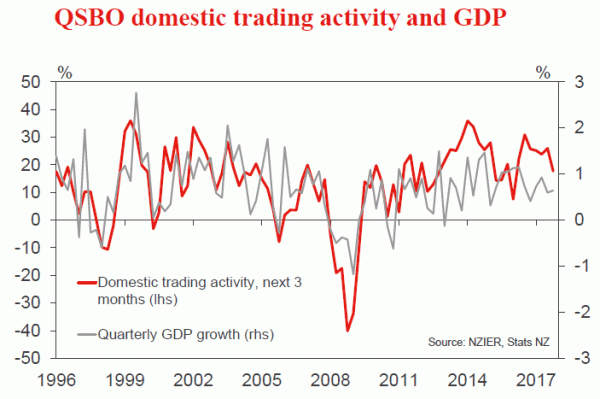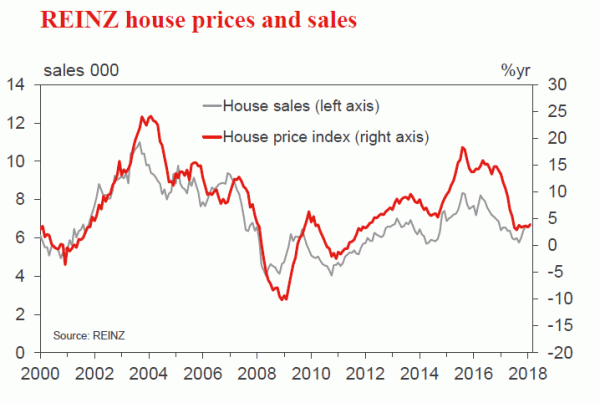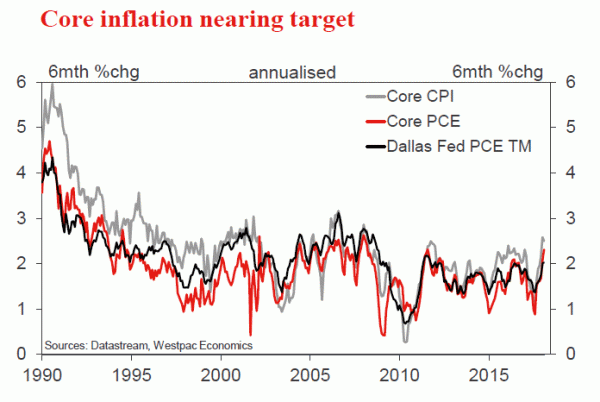Week beginning 9 April 2018
- Gradual decline in the AUD expected to continue through 2018 as USD stabilises; commodity prices fall; and interest margins widen.
- RBA: Governor Lowe speaks, Financial Stability Review.
- Australia: Westpac-MI consumer sentiment, housing finance.
- NZ: retail card spending, house sales and prices.
- China: President Xi speaks, new loans, trade balance.
- Euro Area: industrial production, trade balance.
- US: CPI, FOMC meeting minutes.
- Key economic & financial forecasts.
Information contained in this report current as at 6 April 2018.
Gradual decline in the AUD expected to continue through 2018 as USD stabilises; commodity prices fall; and interest margins widen
Over the last few months the AUD has been generally weaker starting in early February at around USD0.80 and reaching USD0.765 during March. It is now hovering around USD 0.77.
This is broadly in line with Westpac’s view that AUD will gradually weaken over the course of 2018 and 2019.
We retain our “targets” of USD 0.77 by June; USD 0.74 by December and USD 0.70 by end 2019.
It appears that AUD’s 2018 peak will prove to be in late January.
At that time AUD was valued at USD 0.81 and the Trade Weighted Index was around 65.7. Since then the trade weighted index has fallen to 62.5 (down around 5%) while against the USD the AUD has fallen by 5.2%. This weakness in the AUD has coincided with some stability in the US Dollar with the USD Index (DXY) increasing by a modest 1%.
That stability in the USD over the last few months contrasts with 2017 when the Index fell by around 13.5%; while the AUD lifted from USD 0.72 to USD 0.81 or 12.5%.
Over the same period the Trade Weighted Index was relatively steady rising a modest 2.5% emphasising that most of the AUD’s “strength ” against the USD in 2017 was explained by USD weakness.
That period of excessive USD weakness reflected a solid boost in optimism around the world economy. “Risk on” was the catch cry and the “safe haven” USD was out of favour.
That boost in global optimism can be encapsulated in the movement in manufacturing PMI’s over that period. Recently that positive euphoria around global growth appears to be fading.
Manufacturing PMI’s stood out in 2017 as signalling strong contemporaneous global growth. However, movements in these PMI’s have been less encouraging in 2018. The PMI’s are estimated to have bottomed out around September 2016. The global manufacturing PMI lifted from 50.4 (September 2016) to 54 (December 2017 but has fallen) back to 53.2 (March). Respectively Europe (52.6; 60.6; 56.6); US (51.5; 55.5; 55.7); Japan (50.4; 54; 53.1) ; Korea (47.6; 49.9; 49.1)) and China (50.1; 51.5; 51.0) indicate that only the US PMI appears to be continuing the upswing we saw through 2017.
Trade tensions must be impacting confidence although there remains considerable uncertainty over the extent and timing of President Trump’s trade policies. The 25% and 10% tariffs on steel and aluminium announced at the beginning of March were initially imposed on all countries, but subsequently rolled back to only a few nations, including China , although excluding Europe; Brazil; and Canada (among others). This exemption has been enough to hold the EU back from retaliating to date.
China has quickly become the sole focus of the trade debate with tariffs to be imposed on around $50bn of imports from China. Less than 24 hours after this announcement, China retaliated with planned tariffs on $3bn of US imports across 128 products. Further bi-lateral responses have followed. China can be patient and play “the long game” whereas the US, with mid-term elections rapidly approaching, is likely to “blink” before China needs to step back.
Recent developments in global financial markets also point to less of an appetite for the “risk on” trade. LIBOR and BBSW are rising; credit spreads are widening. Equity markets are falling – US down 9%; Europe down 8%; Japan down 12%; and Australia down 5.2% since late January.
One important explanation is the recent US tax changes which allow US corporates (in particular the cash rich technology companies) to direct funds (mainly US dollars) back to the US from foreign sources (total funds estimated at around $1.5 trillion without paying the onerous 35% tax rate). Foreign banks, including Australia, which had relied on this USD funding, have had to switch demand for funds to local markets, intensifying rate pressures. The “shortage” of USD offshore funds has boosted USD funding costs – LIBOR by around 25 basis points.
Most business borrowers will be affected by this increase in BBSW. One small bank even slightly raised its variable mortgage rate to reflect this 25 basis point increase in short term funding costs. Australian banks have also recently suffered increases in their funding costs in longer maturities with bank 5 year paper lifting by around 15 basis points compared to the risk free rate.
Credit growth has slowed to 3.8% annualised over the three months to February compared with 4.9% growth for 2017. This includes a slowing in housing credit growth from 6.3% in 2017 to 6.0% annualised over the past three months. Business credit stalled over the past three months, with 0.4% annualised growth, in contrast to a 3.2% increase in 2017.
Our core reasons for the further expected falls in the AUD centre around expected interest rate differentials and a downswing in commodity prices. We expect to see the cash rate differential between Australia and the US to widen to 112 basis points (from the current 12.5 basis points) by mid-2019; while the 10 year differential is expected to increase from the current 16 basis points to 40 basis points. These forces are also playing out in commodities. The iron ore price has fallen by around 20% since early February while the coking coal price is down by 15%.
A key issue here relates to the slowing in the growth of the shadow banking system in China (asset growth in the first two months of 2018 is down around 65% on 2017). Non-banks have been key financiers of local government (around 80% of infrastructure investment in China); property developers; and commodity speculators.
These forces can be expected to weigh directly on the AUD and will be most clearly signalled by movements in the TWI – note the 5.0% fall in the TWI since late January. However, if global sentiment recovers and starts to weigh on the USD these forces will be obscured when assessing the AUD in terms of the USD.
With this change in global sentiment signalling a neutral USD we can expect falls in the TWI and AUD/USD to be broadly in line with each other as has been the case since late January.
The week that was
This week has again been dominated by Sino-US trade frictions.
We started the week with news that China’s previously-announced retaliation against the US’ steel and aluminium tariffs had come into effect. The US subsequently outlined the 1300 or so Chinese goods that will be affected by their second tariff plan from late March (on $50bn of imports) to which China then responded by announcing their own second package of tariffs (on 108 US imports whose trade also totals $50bn). This additional package was crafted to show China’s might – covering a key selection of US exports to China, from automobiles and planes to soya beans and beef – but also their restraint. On the latter, China again called for negotiations by stating that the new tariffs would only come into effect if the US continued with its plans.
As we have noted repeatedly, there is definitely scope for a positive outcome to this ruction. However, it requires the US to agree to negotiate and compromise. US authorities have generally sounded willing to do so over the past month. But a fresh request today by President Trump to consider tariffs on another $100bn of Chinese imports casts doubts on the intent of the administration. The more rounds of one-upmanship that occur between the US and China, the harder negotiations and resolution will become.
Turning back to Australia’s economy, this week the RBA met, and we also received updates on retail sales; housing; and trade.
Starting with the RBA, in recent communications, the language used to describe the outlook for growth has been adjusted, from “averaging a bit above 3% over the next couple of years” in February to “faster in 2018 than it did 2017” in March. That second statement was then qualified in the March meeting minutes, with growth in 2018 still seen as exceeding potential (typically regarded as 2.75%). Come April, the decision statement again referred to the central forecast being for faster growth in 2018 than 2017; however, by then the 2017 outcome had been reported at just 2.4%. As noted by Chief Economist Bill Evans this week, with “this change in stance around the growth outlook, it is reasonable to assume that the next set of growth forecasts for 2018, which will be released on May 6 with the May Statement on Monetary Policy, will be for a lower forecast than the 3.25% we saw in February”. This accords well with our view that growth will be near trend in 2018 and hence that the RBA will remain on the sidelines through 2018 and 2019. Another important point to note from the RBA statement is the reference to the tightening in financial conditions associated with the increase in USD short-term interest rates, which the Governor noted has flowed through to higher short-term rates in some other countries, including Australia. Whether this is a temporary or permanent phenomenon was not assessed, nor its eventual impact on the economy. See the previous page’s essay for more detail.
On to the Australian data, retail sales for February provided a positive surprise this week. In the month, retail sales rose 0.6% against expectations of a 0.3% rise. The January outcome was also edged up from 0.1% to 0.2%. At 3.0%yr, annual growth is now the strongest it has been since July last year – albeit still well below its historic average. Discretionary spending drove the February result, and online retail continued its strong run. Looking ahead, the January/ February outcomes suggest growth in Q1 will be a step down from Q4 and also well below long-run average levels.
For housing, this week we received CoreLogic house price data for March and dwelling approvals for February. House prices continued to edged lower in March, leaving the national measure 1.4% lower than the October 2017 peak. By city, price weakness remains concentrated in Sydney, –2.1%yr. As for the nation, Sydney house prices have been harder hit, –3.8%yr, particularly at the top end – the top 25% of properties by value have fallen 6.5%yr after a period of outperformance. Elsewhere: Melbourne is still the strongest performer, 5%yr; price growth in Adelaide and Brisbane is negligible, and in Perth, it remains negative, –2%yr. Dwelling approvals meanwhile remain consistent with our expectation of further weakness over the coming year, declining 6.2% in the month of February to be down 3.1%yr. That said, conditions across the states continue to diverge, with Vic up 10–15%yr; NSW up 3%yr; Qld flat; and WA down 8–10%yr. This is also true by dwelling type, with high-rise approvals continuing to dominate the headline measure.
Finally on trade, February saw a second consecutive surplus of $0.8bn, a touch below January’s $1.0bn. The key point from this release is that the Q1 trade position looks as though it will be a marked improvement from Q4, with net exports set to be broadly neutral for growth – as opposed to a material detractor. Related to the trade outlook, recent PMI’s for the Asian region show China holding on to the gains of 2017/18, and many nations in the rest of Asia also faring well – most notably Japan. That said, there is a degree of fragility in these reports. China’s PMI employment indexes have clearly turned down after underperforming the activity measures during the upswing. More broadly, export orders are also showing evidence of weakness across the region.
Chart of the week: Govt issuance and central bank purchases
In our April Market Outlook, we examine how recent changes in US policy will affect the current account imbalance.
A key dynamic set to weigh on the US trade deficit is the Fed’s balance sheet normalisation. Asset purchases from the Fed have been a contributor to federal financing over the post-GFC period. Treasury purchases will now turn to redemptions with the Fed indicating that $230bn will roll off in 2018 and $270bn in 2019. This equates to a lower US supply of loanable funds and will need to be offset by a rise in US net saving or more likely a foreign capital inflow.
Attracting capital from overseas is likely to become more difficult given other major central banks are reducing their purchases. The ECB is expected to halt purchases in 2019, while the BoJ’s increased share of the JGB market (46%) means they need fewer purchases to control the 10yr JGB yield – purchases in 2017 fell to ¥30tn from 2016’s ¥80tn.
New Zealand: week ahead & data wrap
It was a relatively quiet week on the NZ data calendar. Broadbased strength in NZ export commodity prices supported another lift in the commodity price index, while whole milk powder prices unexpectedly ticked higher in the latest GlobalDairyTrade auction. Looking ahead to next week, we will get a read on how businesses sentiment is faring as the dust settles following the change of Government. Anecdotally, changes to labour laws and challenges finding the right staff remain key concerns for firms.
Commodity prices rose 1.2% in March, bringing prices to their highest level since 2014. For the rural sector, and the New Zealand economy more broadly, the real positive is probably the widespread nature of the strength in prices. Beef, lamb, seafood, horticulture and forestry prices are all at robust levels. And while dairy prices aren’t at the front of the pack, recent dairy auctions have shown a lift in whole milk powder prices (a key determinant of the farmgate milk price). This week’s result was a little stronger than we had pencilled in, pushing whole milk powder prices to the highest level since January, and supporting the firm $6.55 payout forecast for the current season.
The highlight for next week is likely to be the release of NZIER’s latest Quarterly Survey of Business Opinion (QSBO). This is probably the most comprehensive read we get on the mood of New Zealand businesses. It’s a useful indicator of how economic activity is shaping up in the first quarter of the year, and also gives us a read on demand for labour and capacity pressures both in the broader economy and the labour market.
Business confidence plunged in the wake of last year’s election and change of government. Although monthly surveys of business confidence have shown some improvement, the level of confidence certainly remains well below levels seen prior to the election. When asked about the outlook for their own businesses however, firms are more upbeat. While the own activity measures in business confidence have also eased since the election, the fall has not been nearly as dramatic. Evidently, firms are much more confident in their own ability to continue to operate given the new political backdrop, than they are in the economy more broadly to adapt to the change.
Our view is that the more pessimistic outlook for the broader economy will lead firms to think twice about their forthcoming investment and hiring decisions. Anecdotally, the cloud of uncertainty surrounding how some of the Government’s policies will be implemented has been relatively slow to clear. For example, firms cite the slow passage of the Employment Relations Amendment Bill (which amongst other things abolishes the 90 day trial period for workers at firms with more than 20 employees and introduces measures designed to allow unions better access to workers) as one source of lingering uncertainty. Questions over just what industry-wide fair pay agreements will entail also remain unresolved for some.
As a consequence of the drop in business confidence, our macroeconomic forecasts incorporate both a lull in business investment and slower growth in employment over the course of 2018 as firms wait for some of this uncertainty to dissipate. Workers seem to agree, with a slight drop in the Employment Expectations component of the latest Westpac McDermott Miller Employment Confidence Survey.
Of course changes to labour laws and the Government’s policy of targeting a $20/hr minimum wage also come at a point in the economic cycle when firms are reporting significant challenges in sourcing both skilled and unskilled labour. In the QSBO these measures of difficulty finding labour have been trending into ‘tighter’ territory, most notably since around 2015, and we will be keeping a close eye on how these measures evolve in next week’s release. Generally, the more difficult it becomes for firms to find the right person for the job, the more pressure we eventually expect to see on wage rates as firms are forced to pay up to attract the staff they need.
Aside from these standard market forces that play a role in setting wages, the government also plays its part by setting the minimum wage. The new Government’s policy is to target a minimum wage of $20/hour by April 2021 (economic conditions permitting). The first step down the pathway to achieving this goal came through on 1 April, when the minimum wage rose from $15.75/hr to $16.50.
Increases to minimum wages have generally outpaced inflation over time. And this year’s 4.8% increase is not that much bigger than we’ve seen in recent years. However, the planned increases over the coming three years are more significant. We expect around 18% of the workforce will be captured by the minimum wage by the time it reaches $20/hr in 2021. Anecdotally firms’ concerns about minimum wage increases extend beyond simply the headline figure. Other workers who are paid a little above the minimum wage are likely to also get an increase in order to maintain relative wage differentials. Compared to other countries, New Zealand’s minimum wage is high relative to the average wage, meaning changes to the minimum wage impact a relatively large share of the workforce (a share which will increase even more as the minimum wage heads towards $20).
The flow on effect on inflation of changes to the minimum wage will depend on the extent to which firms can pass on cost increases. This will vary across industries and with the state of the labour market more generally. A minimum wage hike is unlikely to spark a wage-price spiral on its own, but it could exacerbate one that had already developed. To this end, next week’s QSBO will give us an update on how firms’ cost pressures and pricing intentions have evolved over the last three months.
Data Previews
Aus Apr Westpac-MI Consumer Sentiment
Apr 11, Last: 103.0
The Westpac-Melbourne Institute Consumer Sentiment Index rose 0.2% to 103.0 in March from 102.7 in February. The index remains in net optimistic territory above the 100 mark but below January’s reading of 105.1. The survey detail suggests the negative impact of market volatility on sentiment in February eased but has been partially offset by new concerns about longer term prospects for the economy.
The April survey is in the field over the week ended April 8. Financial markets have again been unsettled, the ASX200 down 2.9% since the March survey and US-China trade relations deteriorating further. Continued house price declines locally are also likely to be weighing on sentiment.
Apr 12, Last: –1.1%, WBC f/c: –1.0%
Mkt f/c: -0.4%, Range: -1.2%% to 1.5%
Australian housing finance approvals had a mixed month in Jan, the number of owner occupier approvals dipping 1.1% but the value of investor loans firming 1.1%. As always, housing data should be treated with extra caution around the summer holiday low period.
Industry figures suggest Feb saw a similar dip in owner occupier approvals – we expect a 1.0% decline. It’s difficult to envisage further gains in the value of investor loans although that would help explain the recent firming in total housing credit growth (i.e. the stock of debt outstanding, changes in which relate to both new loans and repayment behaviour).
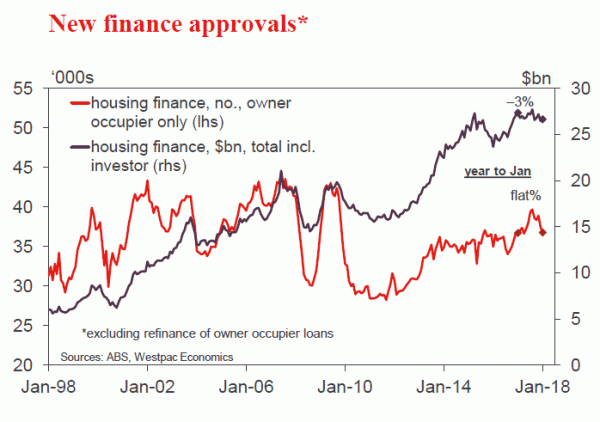 NZ Q1 Survey of Business Opinion
NZ Q1 Survey of Business Opinion
Apr 10, Domestic trading activity – Last: +18
Business confidence fell sharply in the December quarter as firms became more nervous about the outlook for the broader economy in the wake of the change of Government. Firms’ outlook for their own activity also fell albeit not as sharply.
Since then, monthly measures of business sentiment have improved off their lows. However, confidence continues to linger well below pre-election levels. We will be looking to see if this trend rings true for the QSBO as well.
Of interest will be how the survey’s key inflation gauges are tracking. We’ll also take note of how capacity pressures in the construction sector are evolving and any further tightening in labour market indicators.
Apr 12, Last: -0.3%, WBC f/c: +0.6%
Retail spending fell 0.3% in February. However, this followed a large 1.4% gain in January, and still left us with a fairly healthy picture of spending growth over the past year. The softness in February’s spending figures was centred on two categories. The first was consumables, which Stats NZ suggested may have been affected by poor weather through the month. The other was fuel spending, which was weighed down by a fall in prices.
We’re expecting to see a 0.6% gain in retail spending in March, underpinned by a 0.7% lift in core categories. In part, this is a recovery from earlier weather related disruptions. In addition, we expect to see solid increases in categories such as hospitality through the Easter holiday period. Such gains are only partially offset by falls in fuel prices.
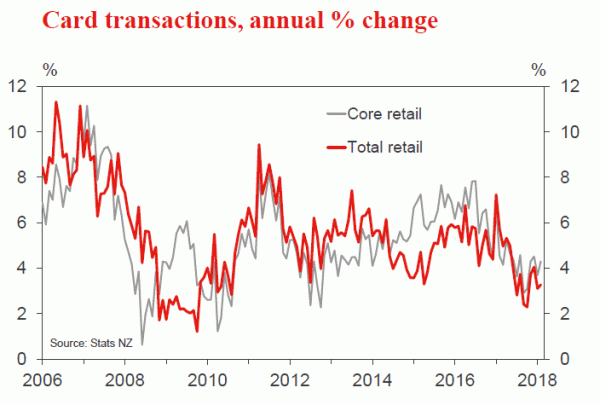 NZ Mar REINZ house sales and prices
NZ Mar REINZ house sales and prices
Apr 9-13 (tbc), Sales last: +1.5%, Prices last: 3.9%yr
After slowing in early to mid-2017, the New Zealand housing market has been more positive in recent months. House prices lifted 1.5% over the three months to February – slightly less in Auckland and Canterbury, slightly more elsewhere. Market turnover has also picked up, albeit less emphatically.
March will probably be another relatively buoyant month. Banks have been reducing mortgage rates and lending more freely.
However, later in 2018 we expect a marked housing market slowdown. The bright-line test for taxing capital gains on resold properties will be extended from two to five years from April 1, foreign buyers will be restricted from mid-year, and further tax changes designed to cool house prices can be expected. At the same time, population growth is slowing and fixed mortgage rates will soon stop falling.
Apr 11, last 0.2%, WBC 0.0%
Headline CPI inflation has settled a little above 2.0%yr in recent months.
Come March, the monthly gain for core prices is likely to again be circa 0.2%; however, for headline inflation, this will be offset by weaker energy prices, leaving total prices little changed for the month.
There will be more movement in the annual rates however, particularly for core inflation. This is because the first of the weak outcomes from 2017 is set to drop out of the annual calculation, March’s –0.1%
Annual core inflation is expected to jump from 1.8%yr to 2.1%yr in the month. Because of the weight of energy prices in the month, annual headline inflation is likely to only edge up 0.1ppt to 2.3%yr.




